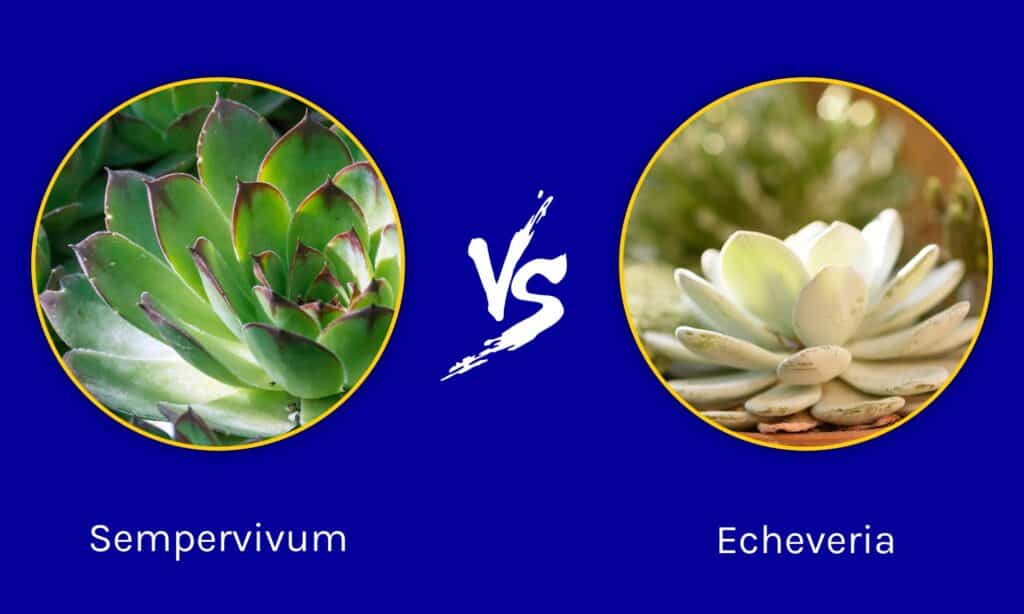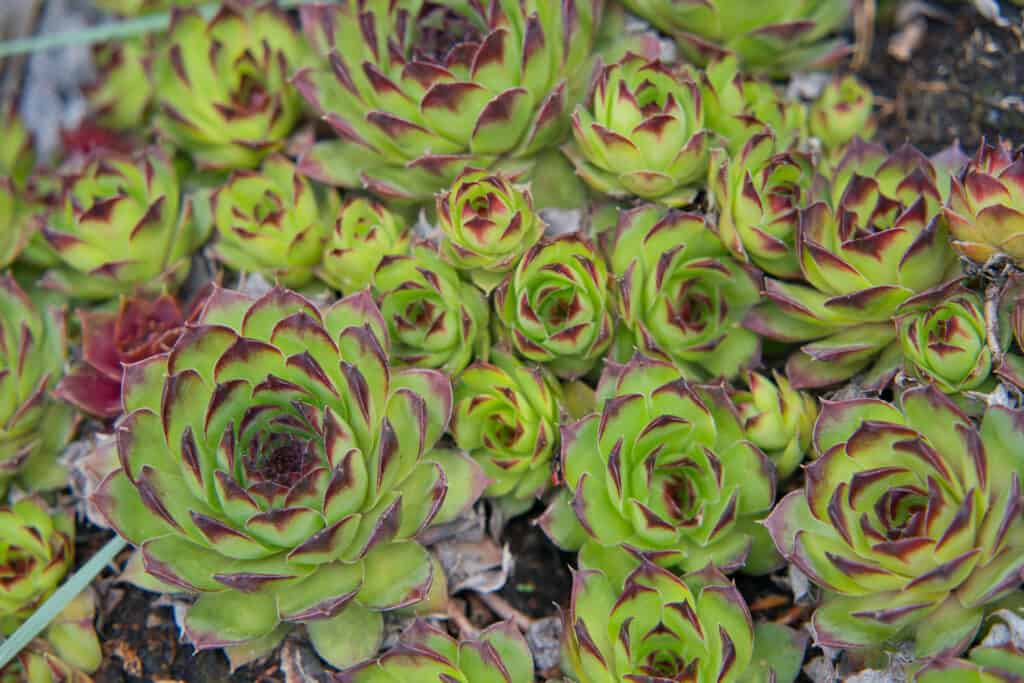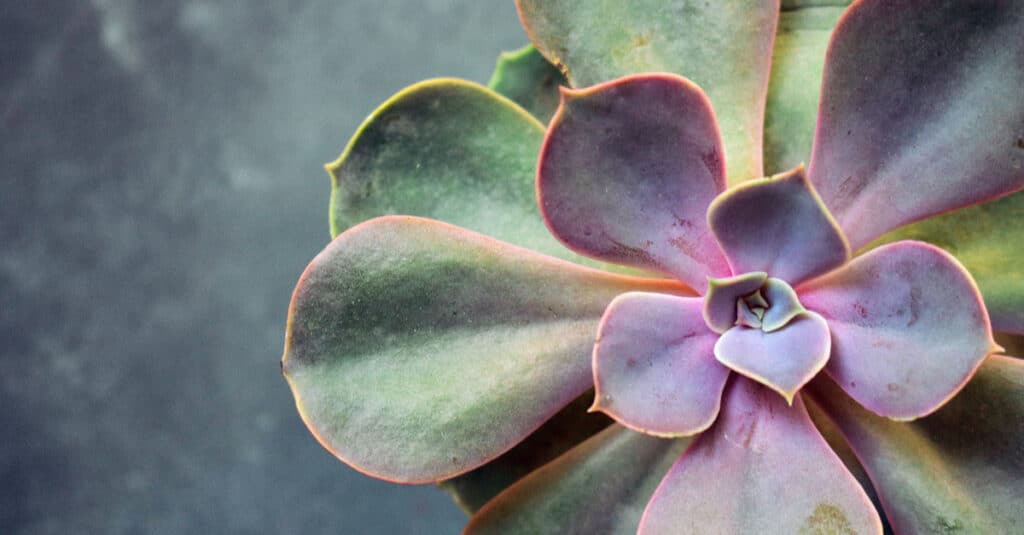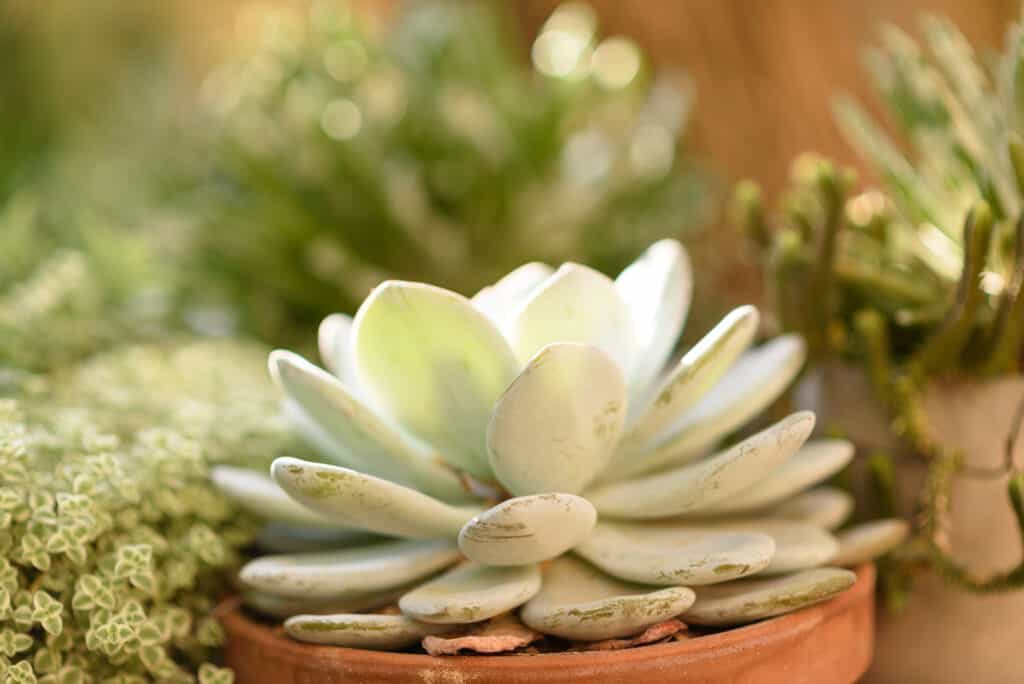Sempervivum and echeveria are often confused because they look so similar. They both grow in a rosette pattern with thick, fleshy leaves. Even the common name Hens and Chicks is used for both plants, even though they are not the same.
These plants come from the same scientific family but are of a different genus. They grow in different environments and come in different colors. Below we will break down all of the similarities and differences in detail.
Comparing Sempervivum vs. Echeveria

| Sempervivum | Echeveria | |
|---|---|---|
| Scientific Family | Family Crassulaceae. Genus Sempervivum. 40 species | Family Crassulaceae. Genus Echeveria. 150 species |
| Common Names | House Leek, Live Forever, Forever Alive, Hens and Chicks | Mexican Snowball, Wax Agave, Hens and Chicks |
| Rosette Size | One inch to 20 inches across | One to five inches across |
| Leaf Description | Narrower than those of echeveria, they have pointy tips and are grayish-green to reddish-brown in color. | Spoon-shaped, gray, green, or bluish in color. Thicker than sempervivum |
| Flower Description | Pink, red, or orange star-shaped flowers originate at the end of fleshy stems that are 6-10 inches tall. | White, orange, pink, or red bell-shaped flowers emerge from stalks that rise up through the leaves. |
| Offsets | Reproduced from offsets attached to a stem that can take root. The stem breaks easily so the offset can form its own roots. | Offsets reproduce outward from a single base stem and form clumps around the mother plant. |
| Origin | Grows wild in Morocco, Iran, the Alps, Turkey, Sahara desert | Central America, Mexico, NW South America |
| USDA Hardiness Zone | Zone 4-9. Can withstand -25°F winter temperature. | Zone 9-12. Can withstand winter temperatures as low as 20°F. |
| Toxicity | Not toxic to humans or pets | Not toxic to humans or pets |
| Uses | Groundcover, terrarium, rock garden, house plant. | Floral arrangement, terrarium, container, living wall, rock garden, and house plant. |
The Key Differences Between Sempervivum and Echeveria
Sempervivum vs. Echeveria: Appearance

The sempervivum has a distinctly star-shaped flower.
©iStock.com/GettyTim82
If you are standing in front of a mystery succulent at the garden center trying to identify it, the easiest way to tell the difference is by the growth pattern. The differences are subtle but easy to identify with a bit of practice.
First, take a careful look at the rosette. The echeveria has a thicker and broader leaf than the sempervivum; if you can hold the two side by side, you will undoubtedly see a difference. The sempervivum has a pointy leaf tip, while the echeveria is smooth and rounded. The rosette’s color will also help you identify your plant. Echeveria is in the blue-gray-green spectrum, while sempervivum leaves tend to have a reddish hue. If the rosette is larger than five inches across, it cannot be an echeveria, as they grow to a maximum size of five inches in diameter.
Next, identify the offsets. If they are growing out of the middle of the mother plant and are sprouting from the end of a long stolon (stem that can grow roots), then you have a sempervivum. If the offsets extend from the edge of the mother plant, attached to the main stem, then you have identified an echeveria.
Lastly, if there are flowers in view, are they star-shaped or bell-shaped? The sempervivum has a distinctly star-shaped flower with six petals. The echeveria has a bell-shaped flower with four or five petals each.
Sempervivum vs. Echeveria: Common Names

Echeveria is called Hens and Chicks, Mexican Snowball, and Wax Agave Plant.
©Inthemood/Shutterstock.com
Most people refer to sempervivum as the Live Forever Plant because it is cold-hardy and comes back even after a hard freeze. Some people also call sempervivum Forever Alive, House Leek, and Hens and Chicks.
Echeveria is called Hens and Chicks, Mexican Snowball, and Wax Agave Plant. They both look like a mother hen surrounded by her babies, so it is no wonder they use the same common name.
Sempervivum vs. Echeveria: Climate
Another significant difference between the two is their preferred climate. Echeveria and sempervivum are both succulents, so they enjoy lots of hot summer sun. The sempervivum doesn’t mind a cold winter and can handle USDA Hardiness zones as low as 4. If you experience a cold winter, the leaves of your sempervivum will die, but don’t panic; the plant will be resurrected by the early summer sun and reward you with new growth.
On the other hand, echeveria is a warm-temperature plant and is perennial in USDA Hardiness zones 4-9. It cannot handle temperatures very far below freezing, and the plant will die as soon as the temperature creeps below 25 degrees Fahrenheit. It is best to bring them inside in the fall to prevent this from happening.
Sempervivum vs. Echeveria: Care

Sempervivum is frost resistant.
©iStock.com/mdragan
When caring for a sempervivum, remember that they store water in their thick, fleshy leaves and do not need frequent watering. Frequent watering will likely cause them to rot. Plant them in sandy soil, a rocky garden, or a terracotta pot.
Sempervivum is frost resistant, but if your area gets below zero temperatures for many months, a thick layer of mulch, like straw or bark chips, will help them bounce back faster in the spring. You can also consider taking them inside for the winter, as they make lovely houseplants.
When caring for an echeveria, a lot of the same wisdom applies. The main difference is the echeveria love a regular and deep watering schedule. When the top three inches of soil are completely dry, give the plant a thorough soak.
Echeveria is not very frost tolerant; temperatures below freezing cause many lower leaves to wither and die. If you live in a cold climate, plant them in pots that you can move into a warm sunroom, garage, or greenhouse for winter. They also like sandy soil and a terracotta pot placed in full sun.
Sempervivum vs. Echeveria: Propagation

Echeveria will flower and seed many times before reaching the end of its life cycle.
©iStock.com/Inna Reznik
Both of these succulents propagate easily by offsets. And they are pretty happy to do this on their own without any help from you. One major difference, however, is that the sempervivum will provide you with one offset, and then the parent plant will die. Echeveria will flower and seed many times before reaching the end of its life cycle.
You can propagate either sempervivum or echeveria by separating the offsets and planting them in a new garden area or a separate pot. You can also take leaf cuttings or propagate from seeds.
If left to their own devices, both plants will form a dense mat of tufted leaves in a rosette pattern formed from the many offsets spreading. Because echeveria produces seeds several times, it spreads faster than sempervivum.
Up Next:
- Succulent vs. Cactus: What’s the Difference?
- Are Succulents Poisonous To Dogs or Cats?
- Easter Cactus vs. Christmas Cactus: Is There a Difference?
The photo featured at the top of this post is © iStock.com/Inna Reznik
Thank you for reading! Have some feedback for us? Contact the AZ Animals editorial team.






